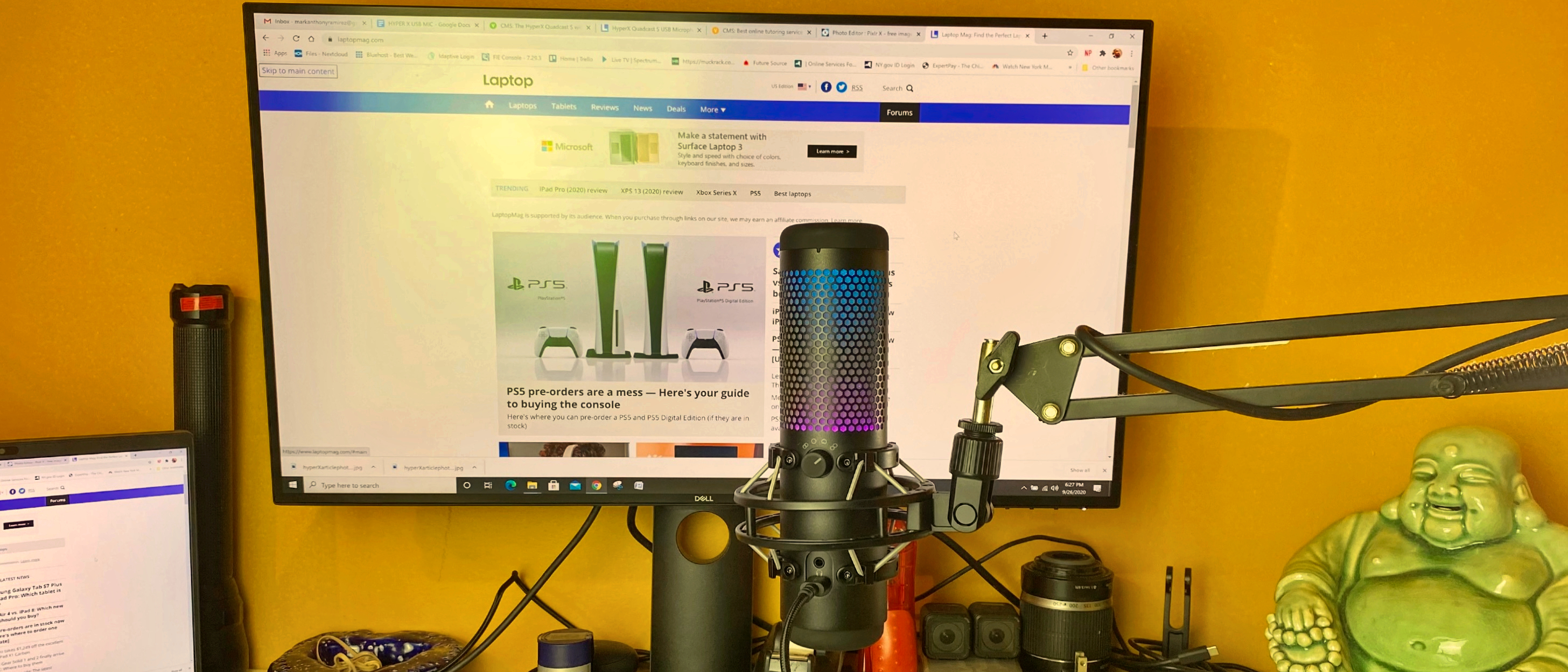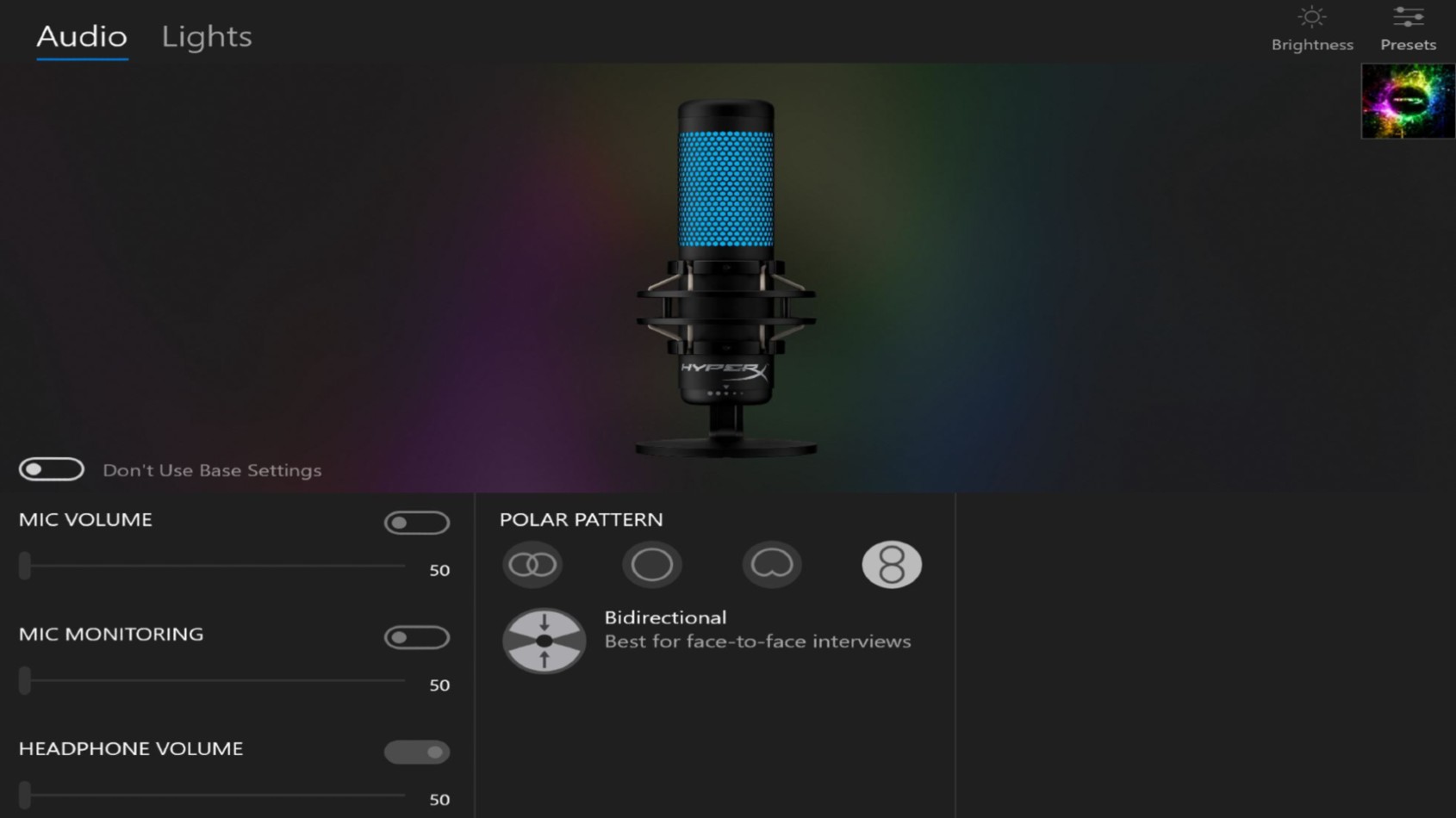Laptop Mag Verdict
The HyperX Quadcast S delivers excellent audio quality in a beautiful form factor that’s pleasing to the eye and to the touch.
Pros
- +
Excellent audio reproduction
- +
Solid build quality
- +
Eye-pleasing design
- +
Touch sensitive mute sensor
- +
Soft-touch gain knob
Cons
- -
Pricey
- -
Software is underwhelming
Why you can trust Laptop Mag
HyperX comes out swinging like 80’s-era Mike Tyson with its new Quadcast S. The all-metal satin-black HyperX S has stand-out design and excellent audio quality, making it one of the best USB mics on the market. The HyperX Quadcast S also features customizable RGB lighting effects to suit your mood and helpful software for tweaking your recordings.
In the end, the HyperX Quadcast S excellently combines eye pleasing aesthetics with high-quality sound recording and streaming performance to justify its high price.
HyperX Quadcast S design
The satin-black HyperX S Quadcast cylindrical styling is lightweight, yet feels solid. The all metal tubular body begs you to grab it and start recording. Housed in the supplied anti-vibration shock mount that connects to the weighted metal stand, the HyperX Quadcast S is not a space hog and fits well on any desk. The mic also comes with an adapter that fits both 3/8-inch and 5/8-inch thread sizes and is compatible with most stands and boom arms.

On the front, you'll find the polar pattern control knob which allows you to easily select the pattern you feel is best for what you’re working on. Further down, is a USB-C port and beneath that, a 3.5mm headphone jack to monitor your audio. At the very bottom is the luxurious round rubber-coated gain knob with it’s smooth gliding action when you turn it in either direction. Moving to the top of the mic, there is a metal grid covering the inner workings of the condenser microphone illuminated by warm RGB lighting. At the very top is a rubber-coated, touch sensitive tap-to-mute sensor.
As I previously mentioned, the Quadcast S (8.5 x 2 inches) is lightweight but sturdy coming in at a total weight of 1.58 pounds when attached to its base and shockmount. The Razer Seiren Emote (3.9 x 7.6 x 3.9 inches) comes in at 1.6 pounds when connected to its base even though it is the smaller microphone. Closing out the group is the Blue Yeti (4.7 x 4.9 x 11.6 inches) which comes in at 2.2 pounds when connected to its base. Neither the Blue Yeti or Razer Seiren Emote come with a shockmount.
HyperX Quadcast S microphone quality
HyperX did an excellent job with the engineering and manufacturing of this microphone. I spent several hours recording voiceover audio, streaming, and chatting in Zoom meetings, and the sound quality produced was on par with the Blue Yeti. Similar to the Blue Yeti, the HyperX has four polar patterns consisting of stereo, omnidirectional, cardioid and bidirectional. These patterns add or subtract certain nuances in the sound recorded and each was crystal clear, capturing all the tones in my voice perfectly. I enjoyed the amount of depth the Quadcast S reproduced in every recording.
I decided to test the bidirectional pattern out by interviewing my significant other. The recording was excellent and equal to the results I got from the Blue Yeti, which is considered the gold standard for USB mics.
Sign up to receive The Snapshot, a free special dispatch from Laptop Mag, in your inbox.

The HyperX Quadcast S condenser capsule surprised me with its clarity. During my testing I only experienced one moment of distortion. And that’s when I had the gain at maximum and started yelling into the mic while watching the Mets lose once again. Once I turned the gain down a tiny bit (I didn’t need it to be all the way up), there was no distortion.
Why am I impressed? Because the Quadcast S sample bit rate of 48kHz/16-bit is less than that of the Elgato Wave 3 (24Bit / 96KHz) yet during my test recordings, I found the Quadcast S recorded higher quality audio. It picked up all the nuances of my voice, including the timbre and bass. Another nice feature of the Quadcast S is the built-in pop filter which helps prevent plosive.
HyperX Quadcast S software
The HyperX Quadcast S is a plug-and-play mic. You can start recording as soon as you connect it to your computer's USB port. You can customize your experience with the HyperX NGENUITY software available for download on the Corsair website. It gives you finer control over mic volume, monitoring, headphone volume and the RGB lighting allowing the user to control the light pattern coloring and speed of transition. If you’re looking for a more interactive lighting scenario, the Razer Seiren Emote uses LED’s and it’s software controls the Emote’s lighting but also an array of expressive emojis that alert the user to likes and new subscribers.

The software is straightforward and easy to use although it doesn’t have the special features of the Elgato’s Wave Link software, which allows you to control multiple audio sources and grants users a soundboard-like control.
Bottom Line
The HyperX Quadcast S is a beautiful USB mic that delivers excellent audio reproduction on par with the Blue Yeti. Its sturdy, show-stopping lightweight design makes it great for recording on the go or in the workplace. However, at $159, it’s pricier than other mid-tier USB mics that record at the same broadcast quality level, such as the Blue Yeti ($129).
This has been my favorite RGB lighting experience on a microphone but, in the end, are you willing to pay an extra $30 for a light show? It’s a matter of preference, but if you’re a streamer, it may pay off to spend the extra cash as your viewers might appreciate the captivating colors. If you decide to spend the extra money, don't worry, you can’t go wrong with the excellent HyperX Quadcast S.

Mark has spent 20 years headlining comedy shows around the country and made appearances on ABC, MTV, Comedy Central, Howard Stern, Food Network, and Sirius XM Radio. He has written about every topic imaginable, from dating, family, politics, social issues, and tech. He wrote his first tech articles for the now-defunct Dads On Tech 10 years ago, and his passion for combining humor and tech has grown under the tutelage of the Laptop Mag team. His penchant for tearing things down and rebuilding them did not make Mark popular at home, however, when he got his hands on the legendary Commodore 64, his passion for all things tech deepened. These days, when he is not filming, editing footage, tinkering with cameras and laptops, or on stage, he can be found at his desk snacking, writing about everything tech, new jokes, or scripts he dreams of filming.

